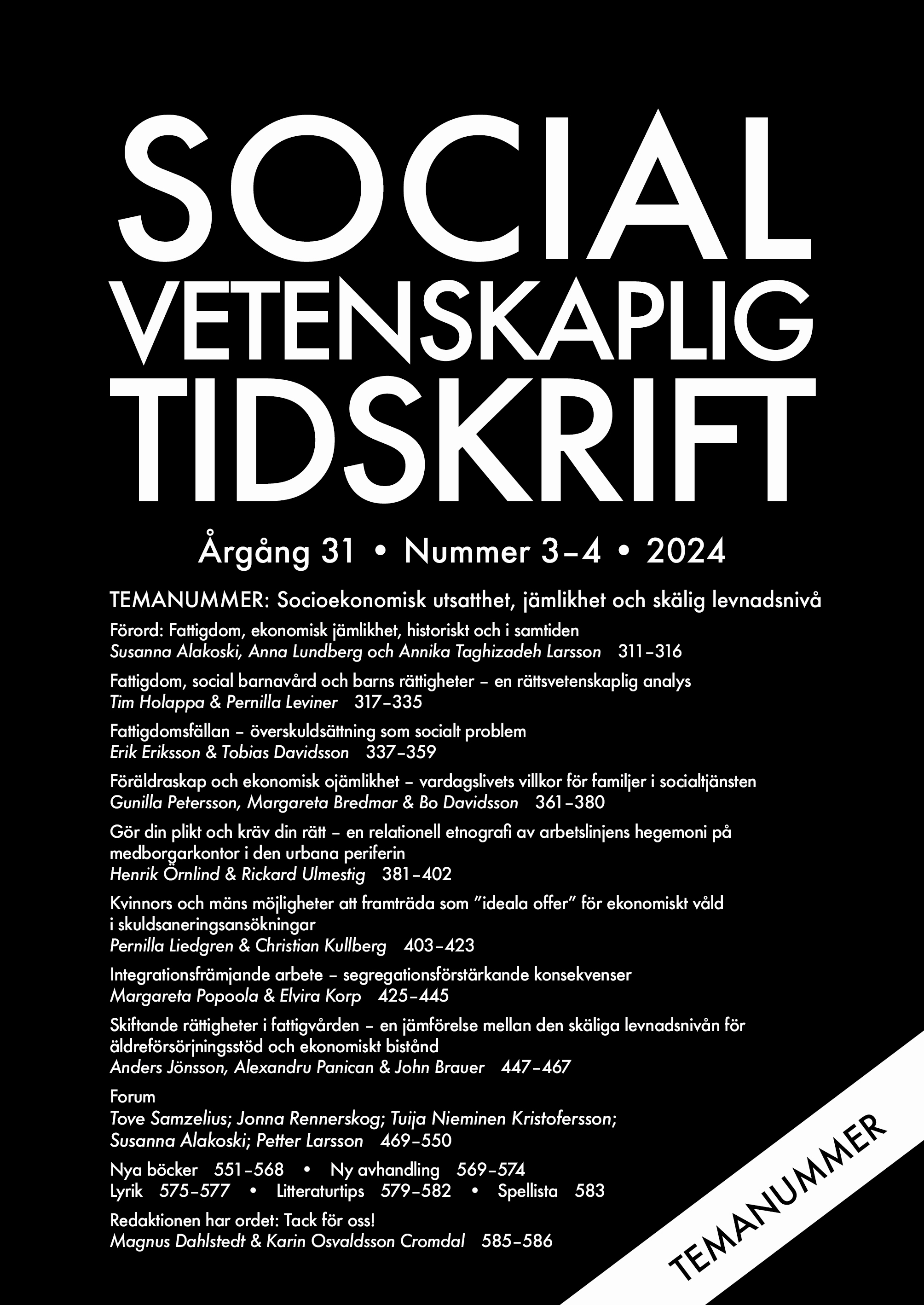Kvinnors och mäns möjligheter att framträda som "ideala offer" för ekonomiskt våld i skuldsaneringsansökningar
DOI:
https://doi.org/10.3384/SVT.2024.31.3-4.5631Nyckelord:
economic abuse, economic exploitation, economic restriction, debt reconstruction, over-indebtedness, ideal victimAbstract
Women's and Men's Opportunities to Appear as 'Ideal Victims' of Economic Abuse in Applications for Debt Relief
Studies show that 13 percent of all women in EU countries have experienced economic abuse in an ongoing or post-separation relationship. However, knowledge about this type of abuse is not well developed. One possible consequence of exposure to economic abuse is over-indebtedness, meaning that the individual can no longer pay off their debts within a foreseeable timeframe.
The purpose of the present study is, with support from Adams et al.’s (2020) model on economic abuse, to examine whether, and if so how, an individual’s exposure to economic abuse appears in men’s and women’s applications for debt relief, as well as assess the effectiveness of Adams et al.’s model in supplementing the analysis. We also aim to analyse the extent to which men's and women's descriptions allow them to appear as more or less "ideal victims" of the abuse they have suffered.
The empirical material consists of debt relief applications submitted to the Swedish Enforcement Authority, along with the personal letters attached to these applications. Decisions, assessments, and service notes have been considered as background material. The applications were analyzed using directed content analysis based on Adams et al.’s (2020) model of economic abuse.
The results show that the applicants’ debt relief applications contain examples of economic exploitation and economic control. The results also indicate that applicants of both genders refer to their own roles in the accumulation and growth of debt in different ways and through various linguistic means, which may influence the extent to which they are perceived as "ideal debt victims."
Referenser
Adams, A., Greeson, M., Littwin, A. & Javorka, M. (2020) The revised scale of economic abuse (SEA2): development and initial psychometric testing of an updated measure of economic abuse in intimate relationships. Psychology of Violence, 10(3): 268–278.
Adams, A., Sullivan, C., Bybee, D. & Greeson, M. (2008) Development of the scale of economic abuse. Violence Against Women, 14(5): 563–588.
Adams, A-E., Tolman, R-M., Bybee, D., Sullivan, C-M., Cris M. & Kennedy, C. (2013) The impact of intimate partner violence on low-income women’s economic well-being: the mediating role of job stability. SAGE: Bibsam: Premier Read & Publish: 2012–12, 18(12): 1345–1367.
Benndorf, F. & Morgell, N-B. (2017) Skuldsaneringslagarna: en kommentar. Stockholm: Karnov Group Sweden AB.
Bruno, L., Sofia, S. & Ekbrand, H. (2024) Men’s economic abuse toward women in Sweden: findings from a national survey. Violence Against Women, online first. doi: 10.1177/10998012241258248
Christie, N. (2001) Det idealiska offret. I: M. Åkerström & I. Sahlins (red.) Det motspänstiga offret (s. 46–60). Lund: Studentlitteratur.
Crossman, K.A. & Hardesty, J.L. (2018) Placing coercive control at the center: what are the processes of coercive control and what makes control coercive? Psychology of Violence, 8: 196–206. doi.org/ 10.1037/vio0000094.
Connell, R. (2002) Gender. Cambridge: Polity Press.
Drijber, B.C., Reijnders, U.J. & Ceelen, M. (2013) Male victims of domestic violence. Journal of Family Violence, 28(2): 173–178.
Fanslow, J., Malihi, Z, Hashemi, L, Gulliver, P. & McIntoch, T. (2021) Change in prevalence of psychological and economic abuse, and controlling behaviours against women by an intimate partner in two cross-sectional studies in New Zealand, 2003 and 2019. BMJ Open, 11(3). 044910. doi: 10.1136/ bmjopen-2020-044910.
FRA (2014) European Union Agency For Fundamental Rights, Violence against women: an EU-wide survey. [https://fra.europa.eu/sites/default/files/fra_uploads/fra-2014-vaw-survey-main-results-apr14_en.pdf].
Fäldt, J. & Kullberg, C. (2012) Genusskapande processer i det sociala arbetets praktik. I: C. Kullberg, M. Hertz, J. Fäldt, V. Wallroth & M. Skillmark Genus i socialt arbete. Malmö: Liber.
Guba, E.G. & Lincoln, Y. S. (1994) Competing paradigms in qualitative research. I: N.K. Denzin & Y.S. Lincoln (red.) Handbook of qualitative research. Thousand Oaks, CA: Sage.
Heuer, J-O (2014) Rules and norms of consumer insolvency and debt relief: a comparison and classification of personal bankruptcy systems in 15 economically advanced countries. Doktorsavhandling. Universität Bremen.
Hiilamo, H. (2018) Household debt and economic crises: causes, consequences and remedies. Cheltenham. Glos, UK: Edward Elgar Publishing.
Hirdman, Y. (1988) Genussystemet:reflexioner kring kvinnors sociala underordning. Kvinnovetenskaplig tidskrift, 3: 49–63.
Howard, J.A. (1984a) The ”normal” victim: the effects of gender stereotypes on reactions to victims. Social Psychology Quarterly, 47(3): 270–281.
Howard, J.A. (1984b) Societal influences on attribution: blaming some victims more than others. Journal of Personality and Social Psychology, 47(3): 494–505.
Hsieh, H-F. & Shannon, S. (2005) Three approaches to qualitative content analysis. Qualitative Health Research, 15(9): 1277–1288. doi: 10.1177/1049732305276687.
Johnson, L., Chen, Y., Stylianou, A. & Arnold, A. (2022) Examining the impact of economic abuse on survivors of intimate partner violence: a scoping review. BMC Public Health, 22: 1014. doi: 10.1186/s12889-022-13297-4.
Jämställdhetsmyndigheten (2023) Delmål 6: Mäns våld mot kvinnor ska upphöra. [https://jamstalldhetsmyndigheten.se/jamstalldhet-i-sverige/delmal-6-mans-vald-mot-kvinnor-ska-upphora/ Hämtat 2023-12-31].
Klapp, O.E. (1954) Villains and fools, as agents of social control. American Sociological Review, 19(1): 56–62. doi:10.2307/2088173.
Kronofogden (2023) Identifiera ekonomiskt våld. [kronofogden.se Hämtat: 2023-12-19].
Kullberg, C. (2012) Inledning: Genus i socialt arbete. I: C. Kullberg, M. Hertz, J. Fäldt, V. Wallroth & M. Skillmark Genus i socialt arbete. Malmö: Liber.
Kullberg, C., Liedgren, P. & Jansson, P. (2023) I’m just a soul whose intentions are good: narratives in applications for debt reconstructions in Sweden. European Journal of Social Work, 26(5): 869–881. doi.org/10.1080/13691457.2022.2115016.
Larsson, B. & Jacobsson, B. (2013) Discretion in the ”backyard of law”: case handling of debt relief in Sweden. Professions and Professionalism, 3(1): 1–17. doi:10.7577/pp.438.
Liedgren, P. & Kullberg, C. (2020) Awaiting absolution: self-presentations in letters of application for debt reconstruction. Nordic Social Work. Publicerad online 9 april. [https://doi.org/10.1080/2156857X.2020.1746388].
Lipsky, M. (2010) Street-level bureaucracy: dilemmas of the individual in public services. Russell Sage Foundation.
NCK (2014) Våld och hälsa: en befolkningsundersökning om kvinnors och mäns våldsutsatthet samt kopplingen till hälsa. Rapport. Nationellt Centrum för Kvinnofrid, Uppsala universitet.
NJA 2010, s. 496.
NJA 2013, s. 128.
Postmus, J., Hoge, G., Breckenridge, J., Sharp-Jeffs, N. & Chung, D. (2020) Economic abuse as an invisible form of domestic violence. Trauma, Violence & Abuse, 21(2): 261–283. [doi.org/10.1177/152483801876416].
Postmus, J., Plummer, S-B. & Stylianou, A. (2016) Measuring economic abuse in the lives of survivors: revising the scale of economic abuse. Violence Against Women, 22(l): 692–703. doi: 10.1177/1077801215610012.
SFS 2016:675 Skuldsaneringslag.
Sharp-Jeffs, N. (2015) Money matters: research in the extent and nature of financial abuse within intimate relationships in the UK. London: The Cooperative Bank.
Skillmark, M. & Kullberg, C. (2022) Att stödja våldsutsatta män och kvinnor: former, omfattning och innehåll. I: M. Skillmark & C. Kullberg (red.) Att möta våldsutsatta män: förståelse, bedömningar och hjälpinsatser. Lund. Studentlitteratur.
Stark, E. (2007) Coercive control: the entrapment of women in personal life. New York, NY: Oxford University Press.
Stark, E. (2009) Rethinking coercive control. Violence Against Women, 15(12), 1509 – 1525.
Stark, E. & Hester, M. (2019) Coercive control: update and review. Violence Against Women, 25(1): 81–104. [https://doi.org/10.1177/1077801218816191].
Tolman, R.M. & Raphael, J. (2000) A review of research on welfare and domestic violence. Journal of Social Issues, 56: 655–682.
Tsui, V. (2014) Male victims of intimate partner abuse: use and helpfulness of services. Social Work, 59(2): 121–130.
Ulmestig, R. & Eriksson, M. (2021) Ekonomisk utsatthet som särskild sårbarhetsfaktor för kvinnor som har brutit upp från män som utövar våld i nära relation. I: L. Moser Hällen (red.) Intersektionella perspektiv på våld i nära relationer (s. 173–185). Stockholm: Liber.
WHO (2021) Violence against women. [https://www.who.int/news-room/fact-sheets/detail/violence-against-women Hämtat: 2023-03-05].
Wilson, B., Zawitkowski, S., Weiss, S., Docherty, L. & Barata, P.C. (2023) How the invisible becomes visible: the lived experience of economic abuse in heterosexual relationships. Violence Against Women, 18: 1–26.
Downloads
Publicerad
Referera så här
Nummer
Sektion
Licens
Copyright (c) 2024 Pernilla Liedgren, Christian Kullberg

Det här verket är licensierat under en Creative Commons Erkännande 4.0 Internationell-licens.




